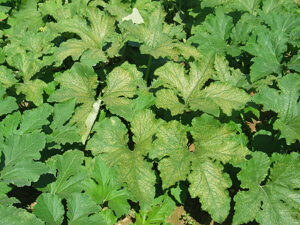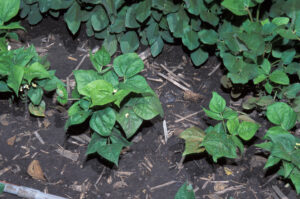When ground level ozone is high enough to trigger an Air Quality Action Day alert from the Indiana Dept. of Environmental Management (IDEM) it is a reminder that crops may be injured by ozone. A number of areas around the state have experienced alerts in recent days, e.g. July 14 in S. Indiana. If crops show the symptoms described below and ozone levels have been high, consider the possibility of ozone injury.
Ozone is a gas with three oxygen atoms per molecule. It is formed in the air when nitrogen oxides and volatile organic compounds react in the presence of sunlight. Ground-level ozone is a primary component of smog. Ozone harms people by aggravating existing breathing problems like asthma and injuring lung tissue. It harms sensitive plants by damaging leaf tissue, reducing the capacity to photosynthesize.
IDEM issues daily air quality forecasts for ground level ozone from May to September, available at , and through the EPA AIRNow app. An Air Quality Action Day is called when ozone (or other pollutants) are expected to be high enough to cause problems for sensitive groups of people. Sensitive plants are injured by ozone at or below these levels. Injury is more likely under hot and humid conditions. Seasonal average ozone levels of 40-60 ppb have been reported to reduce yield of broadleaf crops by 5% to 15%. Indiana counties that have historically experienced frequent high levels of ozone include Lake, Porter, Floyd, and Clark. Figure 1 illustrates days when air quality has been a human health concern around the state over the past month. In most cases the concern has been high ozone levels; around the 4th of July high levels of particulate matter were also a problem in some locations.
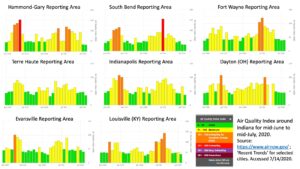
Figure 1. Daily air quality index for reporting areas around Indiana from mid-June to mid-July, 2020. On most days ozone was the pollutant of concern. Source: https://www.airnow.gov.
Symptoms of ozone injury on plants include interveinal chlorosis and necrosis, bleaching, stippling (small darkly pigmented areas approximately 2-4 mm diameter), flecking (tiny light-tan irregular spots less than 1 mm diameter), bronzing, and reddening. Older and middle-aged leaves are usually affected first. Often just the upper leaf surface is affected. On some plants both upper and lower leaf surfaces are affected. The chlorosis and necrosis can be similar to what is seen with normal leaf aging and death. Crops and varieties differ in sensitivity and specific symptoms. The stage of crop growth and environmental conditions also influence the degree of injury observed.
On watermelons injury appears first on older leaves. Areas between veins yellow (interveinal chlorosis) and eventually turn dark and then white (Figure 2). On squash and pumpkins older leaves show interveinal chlorosis and bleaching (Figure 3). On snap beans ozone causes bronzing on upper leaf surfaces and leaves may yellow and die (Figure 4). On potatoes, younger leaves show dark stippling on upper and lower leaf surfaces (Figure 5).
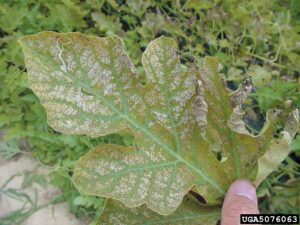
Figure 2. Ozone injury on watermelon leaf. Photo by David B. Langston, University of Georgia, Bugwood.org.
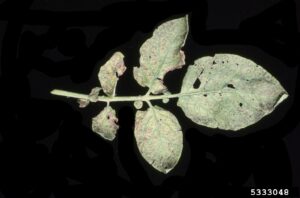
Figure 5. Ozone injury on potato leaf. Photo by Mary Ann Hansen, Virginia Polytechnic Institute and State University, Bugwood.org
If crops show these symptoms, other possible causes are ruled out, and ozone has been high in the area, it is reasonable to suspect ozone injury. To the extent possible, avoid additional stresses on the plants. Don’t apply unwarranted pesticides or nutrients. Note which varieties show fewer symptoms and in the future, select varieties that are less susceptible.
Individuals and businesses can help to reduce ground-level ozone by conserving electricity, refueling vehicles after dusk, limiting engine idling, and using volatile chemicals in ways that keep evaporation to a minimum. For additional suggestions, visit ‘What You Can Do’ at www.airnow.gov.
An earlier version of this article was published in Vegetable Crops Issue 541, July 22, 2011.
References
USDA Professor Kent Burkey Crop and Soil Science.
IDEM 2020. Current Nonattainment Areas. Accessed 7/14/2020
